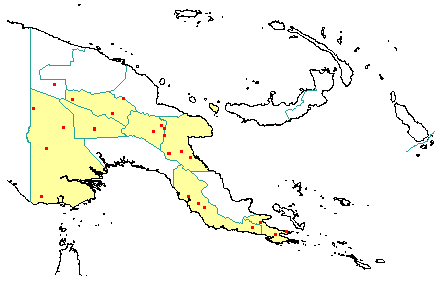
in PNGplants database
PNGTrees – Syzygium claviflorum (Roxb.) Wall. ex Steud. |
Barry Conn (NSW) & Kipiro Damas (LAE).
Copyright held by the authors, Royal Botanic Gardens and Domain Trust, and Papua New Guinea National Herbarium
Nomenclator Botanicum 2nd edition Vol. 2: 657 (1841)
Field Characters: Small trees mostly 5-20 m high or large trees sometimes up to c. 30 m high. Bole cylindrical (up to c. 40 cm diam.); straight (bole up to c. 20 m long); buttresses absent or present; spines absent; aerial roots absent; stilt roots absent. Bark light grey or dark brown, almost smooth or rough, pustular or scaly or flaky; lenticels elongated laterally; subrhytidome pale brown; bark thickness <25 mm thick, 8.0-12.0 mm thick; blaze consisting of one layer; faintly to non-aromatic; outer blaze pale yellow (straw-coloured) or brown, markings absent; inner blaze pale yellow (straw-coloured) or brown, markings absent; exudate absent. Terminal buds not enclosed by leaves; complex hairs absent; stinging hairs absent; mature twig without hairs.
Leaves: Spaced along branches <internodes readily visible>. Leaves opposite, simple; petiole present, not winged, attached to base of leaf blade <not peltate>, not swollen; lamina broadest at or near middle, (3.5-) 5.0-19.3 cm long, 1.6-6.6 cm wide; lamina symmetric, margin entire, not dissected or lobed, apex acuminate, venation pinnate <secondary veins arising from the midrib along its length>, secondary veins closed <spaced so close together that tertiary veins cannot be easily seen between them>, not prominent, but visible, intramarginal veins present; lower surface pale green or green, upper surface dark green (glossy), hairs absent; oil dots present; domatia absent; stipules absent.
Flowers: Inflorescence rarely terminal <at branch ends>, leaf-opposed <arising opposite a leaf, not between a leaf and a branch>, or on the trunk or branches <cauliflorous-ramiflorous>. Flowers on a branched axis; flowers bisexual, stalked, with many planes of symmetry <actinomorphic>, 10.0-26.0 mm long, small (< or =10 mm diam.) to 5.6 mm; perianth present, with distinct sepals and petals, white, green, or cream-coloured; inner perianth 6-8 (falling after anthesis), free; stamens 100, filaments present, free of each other, free of perianth; ovary inferior <seated below the petals and sepals; epigenous>, carpels joined (when more than one) <syncarpous>, locules 2-3; styles solitary <including joined together>, 1.
Fruits: Fruits arranged on branched axis. Fruit 12-14 mm long, 8.0-10.0 mm diam., fruit red, not spiny, fleshy, simple, indehiscent, drupe. Seeds 1, to about 5 mm long, not winged, as wide as long, 1-10 mm diam. (c. 3 mm).
Distribution: Milne Bay, Central, Eastern Highlands, Southern Highlands, Western Highlands, Morobe & Western.
 | Botanical records in PNGplants database |
Notes: This species is regarded as part of the segregate genus Acmenosperma by some researchers. This species is characterised as having clavate flower buds, flowers often arranged in clusters, and fruits that are cylindrical to pyriform; features characteristic of Acmenosperma. In this account of Syzygium claviflorum, a broad generic concept has been applied that regards Acmenosperma as a synonym of Syzygium.